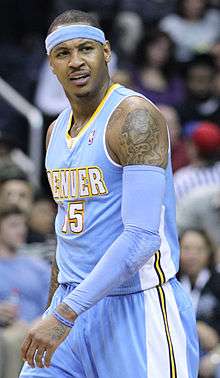Basketball uniform
A basketball uniform is a type of uniform worn by basketball players. Basketball uniforms consist of a jersey that features the number and last name of the player on the back, as well as shorts and athletic shoes. Within teams, players wear uniforms representing the team colors; the home team typically wears a lighter-colored uniform, while the visiting team wears a darker-colored uniform.
Different basketball leagues have different specifications for the type of uniform that is allowed on the court. Early in the history of the sport, basketball was played in any type of athletic attire, but by the 1900s, special uniforms were developed and marketed to basketball players. The style, cut, and fit of basketball uniforms evolved throughout subsequent decades, often modeled after the general fashion trends of the day.
History
Jerseys and shorts


Originally, basketball was played in any type of athletic attire, ranging from track suits to football uniforms. The first official basketball uniforms, as displayed in the Spalding catalog of 1901, featured three types of pants: knee-length padded pants, similar to those worn for playing football, as well as shorter pants and knee-length tights. There were two types of suggested jersey, a quarter-length sleeve and a sleeveless version.[1]
The long pants later evolved into medium-length shorts in the 1920s, and by the 1930s, the material used for jerseys changed from heavy wool to the lighter polyester and nylon. In the 1970s and 80s, uniforms became tighter-fitting and shorts were shorter, consistent with the overall fashion trends of these two decades.[2] At this time, women's basketball uniforms transitioned from longer-sleeved uniforms to tank-top style jerseys similar to men's basketball uniforms, which more explicitly showed off players' muscle tone.[3]
In 1984, Michael Jordan asked for longer shorts and helped popularize the move away from tight, short shorts toward the longer, baggier shorts worn by basketball players today.[4][5] Throughout the 1990s, basketball uniforms fell under the influence of hip hop culture, with shorts becoming longer and looser-fitting, team colors brighter, and designs more flashy and suggestive of rappers' bling.[6] At the turn of the 21st century, basketball uniforms became even more oversized and loose-fitting; the arm holes in women's basketball jerseys remained smaller than men's, but were wide enough to reveal the players' sports bras.[3]
For the Christmas Day games of 2013, the NBA introduced a newly designed sleeved jersey with large team and NBA logos on the front.[7] Marketers for the new uniforms realized that fans were unwilling to wear sleeveless jerseys in their day-to-day life and hoped the new sleeved jerseys would be more popular for everyday wear.[8]
Shoes
In 1903, a special basketball shoe with suction cups to prevent slippage was added to the official basketball uniform demonstrated in the Spalding catalog.[1] Over the decades, different shoe brands and styles were popular as basketball shoes: Chuck Taylor All-Stars and Keds in the 1960s and 70s; Adidas and Nike leather high-tops in the late 1970s and 80s; and Air Jordans in the 1990s.[4]
Accessories
In the 1970s, Slick Watts and Bill Walton began to wear headbands, which soon became popular with other players. Rick Barry popularized wrist-bands, and other players soon created variations, such as bands that covered their forearms or biceps. These were used to wipe off sweat, or simply worn as fashion statements.[4]
Modern day
United States basketball
Rules and regulations
In professional basketball leagues today, teams playing at home typically wear lighter-colored uniforms than the visiting team.[9]
In the NBA, basketball shorts must fall at least 1 inch above the knee, and T-shirts cannot be worn under the jersey – however, they are permitted in American college basketball. Unlike European basketball leagues, the NBA forbids the display of commercial logos on players' uniforms, with the exception of players' shoes.[9] Some WNBA teams have allowed sponsors' logos to appear on their uniforms.[10]
Material
Uniforms are made of wicking material designed to absorb sweat and ensure that it evaporates faster.[2] They are the product of a four-year study researching professional basketball players, who identified the need for fewer seams, lighter weight, and faster drying and cooling in their jerseys.[5]
International basketball leagues
The main difference between U.S. basketball uniforms and those of other countries is the appearance of sponsorship iconography; European basketball uniforms are often covered in the logos of their sponsors.[11]
See also
References
- 1 2 James Naismith (1941). Basketball: Its Origin and Development. U of Nebraska Press. pp. 89–90. ISBN 0-8032-8370-9.
- 1 2 Lucia Raatma (1 January 2012). The Curious, Captivating, Unusual History of Sports. Capstone Press. p. 13. ISBN 978-1-4296-7537-6.
- 1 2 Sarah McCullough (2007). Construction of the Female Athletic Body: A Study of Women's Sport Uniforms. ProQuest. pp. 76–78. ISBN 978-0-549-26375-3.
- 1 2 3 Nate LeBoutillier (1 January 2011). The Best of Everything Basketball Book. Capstone. pp. 58–59. ISBN 978-1-4296-5468-5.
- 1 2 Suzanne Slade (1 January 2013). The Technology of Basketball. Capstone. pp. 20–21. ISBN 978-1-4296-9956-3.
- ↑ Jeffrey Lane (1 December 2007). Under the Boards: The Cultural Revolution in Basketball. U of Nebraska Press. p. 41. ISBN 0-8032-0755-7.
- ↑ Patt, Jason. "NBA Christmas Day uniforms 2013: Teams to wear new sleeved jerseys". SBNation. Retrieved 25 December 2013.
- ↑ Holmes, Elizabeth. "NBA Christmas Jerseys—Now With Sleeves". WSJ Online. Retrieved 25 December 2013.
- 1 2 P. J. Harari; Dave Ominsky (1 October 2002). Basketball Made Simple: A Spectator's Guide. First Base Sports, Inc. p. 10. ISBN 978-1-884309-13-7.
- ↑ Sandomir, Richard (31 May 2009). "In W.N.B.A., Jersey Sponsorship Could Set New Standard". The New York Times. Retrieved 25 December 2013.
- ↑ O'Brien, Dan. "NBA Debate: Should the NBA Put Advertisements on Jerseys?". The Bleacher Report. Retrieved 25 December 2013.